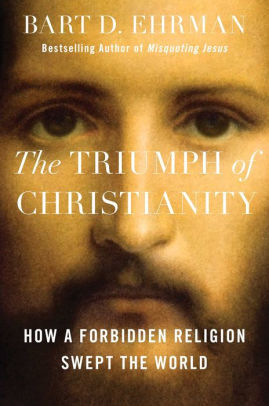The Triumph of Christianity
- By Bart D. Ehrman
- Simon & Schuster
- 352 pp.
- Reviewed by Bob Duffy
- April 12, 2020
From Paul to Constantine, a modest faith’s stunning rise to prominence.

It’s a remarkable saga. In a span of barely 350 years, what begins as a tiny Jewish sect, just three-dozen strong, spreads across the Mediterranean world to become the official state religion of the Roman Empire.
This is the fascinating story that New Testament scholar Bart D. Ehrman tells in The Triumph of Christianity. But don’t tackle this erudite volume in search of cloud-splitting fireworks — either of the divine-intervention or 1950s Cinemascope sort.
Ehrman’s book remains solidly grounded in first-rate scholarship. And although a few loony emperors do lurk about and the (very) occasional persecution arises, the reader in search of the dramatic, the sentimental, or the miraculous is likely to find scant fulfillment here.
Two significant conversions serve as frames for Ehrman’s discussion. The first: that of Paul of Tarsus, a Greek-speaking Jew of the Pharisaical persuasion. Outraged by claims from Jesus’ followers that their crucified leader is the long-awaited Messiah, Paul becomes a violent persecutor of this new Jewish sect — until his celebrated flash-bang conversion a few years later.
While Ehrman respectfully acknowledges both received tradition and scripture, he skillfully deconstructs the conflicting documentary evidence of Paul’s pivotal moment. Did he actually see a blinding light and hear the admonitory voice of Jesus? Was he on the road to Damascus, or in Damascus itself, when he experienced the shattering insight that would ultimately alter the history of Western culture?
Whatever the nature of Paul’s vision, for author Ehrman, this first-century Jew from present-day Turkey was “the most significant Christian convert of all time.”
After his vision, Paul would set out on a proselytizing mission that was to span national (or, in Roman terms, provincial) borders and eventually reach the empire’s capital city. During his lifelong mission, Paul writes his Epistles: monumental affirmations of faith, community, and love celebrating the risen Jesus as divine.
At the same time, these letters propound a revolutionary doctrine: that Jesus’ death and resurrection brought salvation to all, Jew and Gentile alike. In 64 CE, about 30 years after he embarked on his mission, Paul, along with the Apostle Peter, is put to death in Rome, a victim of Nero’s fraudulent campaign to blame the Christians for the massive Roman fire of the same year.
At the other end of the story, in 312 CE, there’s a second history-making conversion, that of the Emperor Constantine. The contemporary historian Eusebius describes the event as a visionary experience. It’s one, for the modern reader, that bears a remarkable resemblance to Paul’s variously reported moment of insight.
Constantine, on the eve of battle, sees a cross-like object in the sky, with “in hoc signo vinces” (“under this sign you will conquer”) emblazoned beneath it. On consultation with his advisors, Constantine concludes that exclusive devotion to a single god is the right path for him, personally and politically. Seventy years later, after a run of several Christian emperors (with one exception), Christianity is enshrined as the official religion of the Empire.
Ehrman, author or editor of 30 books on the religious environment of the period, turns to the historical record, supplemented by modern statistics, to peg the Christian population of the empire at 30 million by 400 CE. This may seem like an astounding advance in numbers, but Ehrman calmly delineates the sound statistical case that Christianity enjoyed a “steady and plausible rate of growth” to embrace half the empire’s population.
Still, Rome, in the first four centuries CE, was swarming with religions, including many so-called Mystery cults centered on the worship of gods violently done to death, only to rise again later. (At least one of these, as Apuleius [c.120-170 CE] describes in his picaresque narrative, The Golden Ass, involves a ritual wherein the initiate undergoes a displaced though superficially bloody recreation of the god’s death and resurrection.)
So what accounts for Christianity’s preeminent success in drawing converts? Ehrman suggests two factors, both related, from this reviewer’s perspective, to a convert’s need for felt community. In the first place, Roman religions — whether cults worshipping luminaries from the “classical” pantheon, or regional/local/household gods or figures from the Mysteries — made no claims on a devotee’s select loyalty. He or she could simultaneously worship gods or goddesses of any flavor, from any cult.
Christian practice, on the other hand, was exclusivist: The devotee had to worship only the (tripartite) Christian god and reject all others. (We risk a disorienting leap into the banal by pointing out that modern branding research has demonstrated the appeal of membership in a shared and exclusive community. Know any Apple fans?)
A second, and perhaps more telling, point: The practice of Roman Christianity extended well beyond the “cultic” nature of other religions of the day. When their pagan counterparts took part in rituals, it was one-and-done: this was the extent of their religious exercise (and spiritual obligations).
For their part, Christians prized loving community as lived in a world that was an extension of the ritual space. They gathered in non-ceremonial contexts, shared good fortune, helped indigent members, and perhaps provided rudimentary healthcare.
In short, one could argue (although Ehrman stops short of asserting this) that they walked the talk ascribed to Jesus and promulgated by his most-inspired advance man.
We don’t need the heavens to open, or the home team to triumph in a brilliantly filmed, thrills-and-spills chariot race, to gasp at the stunning ascent of this humbly spawned religion. Or later, perhaps, to reflect on what this church’s rise to dominance has meant in the centuries since.
[Editor's note: This review originally ran in 2018.]
Former academic Bob Duffy is a Maryland author and consultant in branding and advertising.

_80_120.png)